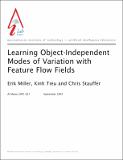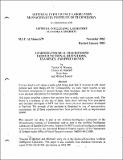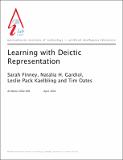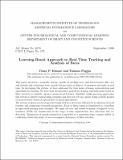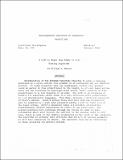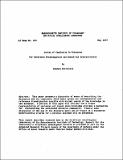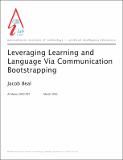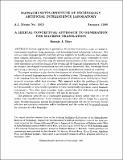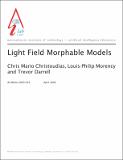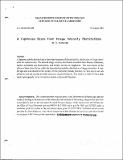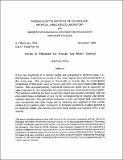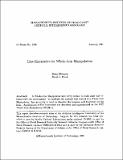Browsing AI Memos (1959 - 2004) by Title
Now showing items 543-562 of 1217
-
Learning Object-Independent Modes of Variation with Feature Flow Fields
(2001-09-01)We present a unifying framework in which "object-independent" modes of variation are learned from continuous-time data such as video sequences. These modes of variation can be used as "generators" to produce a manifold of ... -
Learning Physical Descriptions from Functional Definitions, Examples, and Precedents
(1982-11-01)It is too hard to tell vision systems what things look like. It is easier to talk about purpose and what things are for. Consequently, we want vision systems to use functional descriptions to identify things when ... -
Learning with Deictic Representation
(2002-04-10)Most reinforcement learning methods operate on propositional representations of the world state. Such representations are often intractably large and generalize poorly. Using a deictic representation is believed to be ... -
Learning-Based Approach to Estimation of Morphable Model Parameters
(2000-09-01)We describe the key role played by partial evaluation in the Supercomputing Toolkit, a parallel computing system for scientific applications that effectively exploits the vast amount of parallelism exposed by partial ... -
Learning-Based Approach to Real Time Tracking and Analysis of Faces
(1999-09-23)This paper describes a trainable system capable of tracking faces and facialsfeatures like eyes and nostrils and estimating basic mouth features such as sdegrees of openness and smile in real time. In developing this ... -
A Left to Right then Right to Left Parsing Algorithm
(1968-02-01)Determination of the minimum resources required to parse a language generated by a given context free grammar is an intriguing and yet unsolved problem. It seems plausible that any unambiguous context free grammar could ... -
Lens Distortion Calibration Using Point Correspondences
(1996-12-01)This paper describes a new method for lens distortion calibration using only point correspondences in multiple views, without the need to know either the 3D location of the points or the camera locations. The standard ... -
LetS: An Expressional Loop Notation
(1983-02-01)Many loops can be more easily understood and manipulated if they are viewed as being built up out of operations on sequences of values. A notation is introduced which makes this viewpoint explicit. Using it, loops can ... -
Levels of Complexity in Discourse for Reference Disambiguation and Speech Act Interpretation
(1977-05-01)This paper presents a discussion of means of describing the discourse and its components which makes speech act interpretation and reference disambiguation possible with minimal search of the knowledge in the database. ... -
Leveraging Learning and Language Via Communication Bootstrapping
(2003-03-17)In a Communication Bootstrapping system, peer components with different perceptual worlds invent symbols and syntax based on correlations between their percepts. I propose that Communication Bootstrapping can also be ... -
A Lexical Conceptual Approach to Generation for Machine Translation
(1988-01-01)Current approaches to generation for machine translation make use of direct-replacement templates, large grammars, and knowledge-based inferencing techniques. Not only are rules language-specific, but they are too ... -
Lexical Conceptual Structure and Generation in Machine Translation
(1989-06-01)This report introduces an implemented scheme for generating target- language sentences using a compositional representation of meaning called lexical conceptual structure. Lexical conceptual structure facilitates two crucial ... -
Lifting Transformations
(1991-12-01)Lifting is a well known technique in resolution theorem proving, logic programming, and term rewriting. In this paper we formulate lifting as an efficiency-motivated program transformation applicable to a wide variety ... -
Light Field Morphable Models
(2003-04-18)Statistical shape and texture appearance models are powerful image representations, but previously had been restricted to 2D or simple 3D shapes. In this paper we present a novel 3D morphable model based on image-based ... -
Light Source Effects
(1977-05-01)The perception of surface luster in achromatic single view images seems to depend on the existence of regions with source-like properties. These regions are due to the interaction of specular component of the surface's ... -
A Lightness Scale from Image Intensity Distributions
(1981-08-01)A lightness scale is derived from a theoretical estimate of the probability distribution of image intensities for natural scenes. The derived image intensity distribution considers three factors: reflectance, surface ... -
Limitations of Geometric Hashing in the Presence of Gaussian Noise
(1992-10-01)This paper presents a detailed error analysis of geometric hashing for 2D object recogition. We analytically derive the probability of false positives and negatives as a function of the number of model and image, ... -
Limitations of Non Model-Based Recognition Schemes
(1991-05-01)Different approaches to visual object recognition can be divided into two general classes: model-based vs. non model-based schemes. In this paper we establish some limitation on the class of non model-based recognition ... -
Limits of Precision for Human Eye Motor Control
(1989-11-01)Dichoptic presentation of vernier stimuli, i.e., one segment to each eye, yielded three times higher thresholds than binocular presentation, mainly due to uncorrelated movements of both eyes. Thresholds allow one to ... -
Line Kinematics for Whole-Arm Manipulation
(1991-01-01)A Whole-Arm Manipulator uses every surface to both sense and interact with the environment. To facilitate the analysis and control of a Whole-Arm Manipulator, line geometry is used to describe the location and trajectory ...

